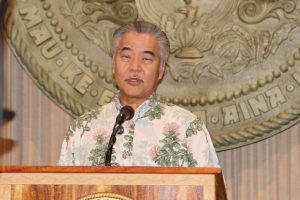Ige Invites All Travelers Back to Hawai´i in Major Policy Shift

The State of Hawai´i wants you back. All of you.
Governor David Ige on Tuesday broke from a long-held position that all travel to and within the Hawaiian Islands should be limited to essential purposes whenever possible, discouraging trans-Pacific visitors from both domestic and international points of origin from visiting the state. He did so from the podium at a ceremony opening a permanent federal inspection station at Ellison Onizuka Kona International Airport (KOA).
“I think we are all encouraged by what we’ve seen over the last several weeks with the continuing trend of lower and lower case counts,” Ige said. “Our hospitals are doing better. We have less COVID patients in them. And, I think most importantly, our healthcare system has responded and feels like we do have the ability to move forward with economic recovery.”
At one point, the state’s 7-day average of newly identified COVID-19 infections topped out at over 900. As of Tuesday, that number was 117 and falling.
“Because of this, it is now safe for fully-vaccinated residents and visitors to resume non-essential travel to and within the State of Hawai´i,” the governor continued. “Beginning Nov. 1, we want to invite and encourage fully-vaccinated visitors and residents to travel for business or leisure, trans-Pacific and interisland.”
Officials from the state’s tourism industry were unsurprisingly supportive of the governor’s public rhetoric, as his discouragement of tourism and other types of non-essential travel is believed to have contributed to a downturn in visitor arrivals to the Hawaiian Islands over the months of August, September and October 2021.
“The local tourism industry is pleased that Governor Ige signaled today that he is ready to welcome non-essential travelers back to Hawai‘i beginning Nov. 1,” Hawai‘i Lodging & Tourism Association President and CEO Mufi Hannemann said in a statement.
“We look forward to working with Governor Ige and his administration to shape a clear message to prospective travelers that Hawai‘i is open for business and travel can once again be booked with confidence,” Hannemann continued.
A Long Time Coming
Travel restrictions arrived in Hawai´i in March 2020, on the heels of the state’s first confirmed cases of COVID-19. At certain points immediately after mandatory quarantines were issued, visitor arrivals dropped upwards of 99%, obliterating Hawai´i’s ‘tourism-first, everything else a distant-second’ economy.
Ebbs and flows in the strength and presence of the virus in the Hawaiian Islands led to a herky-jerky sort of reopening process, which saw testing requirements and vaccination exemptions create and alter travel paradigms, both interisland and trans-Pacific. Confusion and frustration also mounted, among both travelers and business owners reliant on the dollars they bring.
The arrival of the Delta variant to Hawai´i, and the accompanying surge in cases and hospitalizations, halted what felt like a hesitant but slow progression back toward a pre-pandemic tourism norm. It also led the governor to issue comments that clearly impacted travel plans of many Americans.
“We know that it is not a good time to travel to the islands,” Ige said during a press conference on Aug. 23, 2021. “The visitors who choose to come to the islands will not have the typical kind of holiday that they expect to get when they visit.”
Visitor totals since early September hovered around, or often slightly below, 20,000 daily. Those daily numbers were down between 25-40% to the corresponding dates in September and October of 2019, according to data provided by the State Department of Business, Economic Development & Tourism.
In his promotion of the new federal inspection station at KOA on Tuesday, Ige outlined the kind of economic impact just one daily flight from one international destination has proven to have on the Big Island’s and the state’s economy.
“One daily flight from Japan can generate over $100 million in annual visitor spending on Hawai´i Island and bring in more than $10 million to state tax revenues and support 1,200 jobs here on Hawai´i Island,” the governor said.





